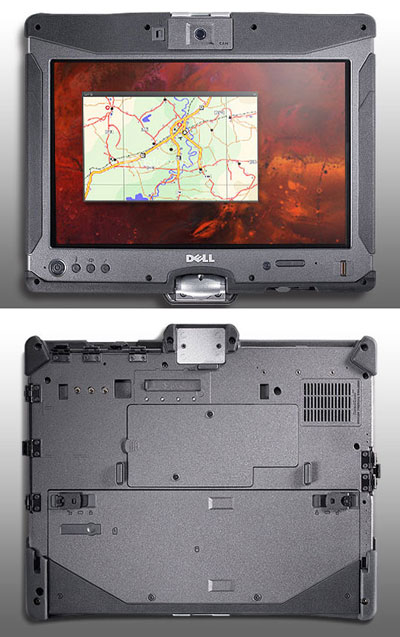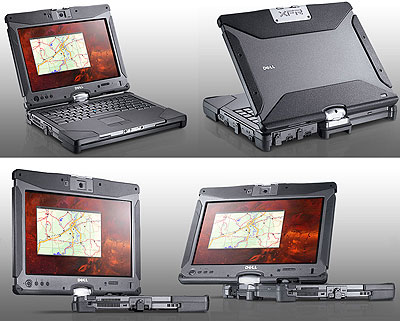|
Dell Latitude XT2 XFR
Dell's multi-touch XT2 Tablet PC convertible gets the rugged XFT treatment
(by Conrad H. Blickenstorfer)
On October 27, 2009, Dell introduced the Latitude XT2 XFR, a ruggedized version of their Latitude XT2. What you get here is a toughened-up version of Dell's sleek convertible Tablet PC, one that is sealed against the elements, can handle desert-hot and icy-cold, and is altogether better equipped to handle life on the road where things can get bumped and dropped. The price premium for that extra toughness is steep. With a starting price of US$3,599 the XFR version costs almost twice as much as the standard commercial XT2 (see our full review of the Dell XT2).

The XT2 XFR is what is generally described as a notebook convertible (or convertible notebook; everyone has their own terminology) that can be used both as a conventional notebook computer and also as a pen tablet (see picture above). The conversion is accomplished by rotating the display clockwise on its pivot hinge until it faces away from the user, then closing the lid, with the LCD display now facing up. This is a design solution that has, in this form, been around since 2001 when Acer and then Toshiba began showing convertible notebook prototypes.
Below you can see the special pivoting display hinge and how it allows the XT2 XFR's LCD to be twisted into different positions for different purposes.

From a technology standpoint, the XT2 XFR, like its civilian counterpart, is well equipped. Power is provided by a 1.6GHz Intel Core 2 Duo SU9600, a speedy and frugal chip that's an excellent choice for this type of machine. The machine comes standard with a gigabyte of DDR3 RAM, upgradeable to 5GB. You get a shock-mounted 5400rpm 160GB disk, or you can opt for a 64 or 128GB solid state disk. The display measures 12.1 inches diagonally and uses the "wide" 16:10 aspect ratio with 1280 x 800 pixel resolution. Unlike the majority of pen input devices that use the Wacom digitizer, Dell chose N-trig DuoSense technology that provides both pen and capacitive touch. Why both? Because there are applications where touch is the best input method, and other application where the precision and cursor-tracking of an active digitizer works best.
Dell emphasizes the multi-touch capabilities of this machine. That's because ever since the Apple iPhone burst onto the scene with its intuitive, elegant two-finger pinching, swiping and tapping, everyone else has been trying to do the same. The problem is, it isn't easy to achieve the iPhone's functionality. N-trig had an advantage as the technology does support multi-touch, and so you can do some multi-touch gestures on the XT2 XFR. A few weeks prior to the release of the XT2 XFTR we tested the standard XT2 and we expect multi-touch on the XT2 XFR to be similar or the same. When you do a multi-touch gesture on the XT2, an icon pops up on the screen as a visual reminder of what you're about to do. You can:
- Scroll by placing two fingers onto the screen and then drag them left, right, up or down.
- Rotate by placing one finger and then moving another finger around it.
- Zoom by touching the screen with two fingers and then pinching them or moving them apart.
- Double-tap with two fingers can generate a user-defined command to the computer.
It's certainly interesting to have this new capability but on our XT2 not all applications supported it, and it all felt a bit forced. That machine used Windows Vista and it is quite possible that things work better under Windows 7 on the XT2 XFR.
As far as ruggedness goes, the Dell Latitude XT2 XFR boasts an exceptionally wide operating temperature range of -10 to 140 degrees Fahrenheit. That is more than most rugged machines can handle. Sealing, expressed in an ingress protection rating, is at the IP54 level. The "5" means that the machine is mostly protected against dust, and the "4" means it's also protected against water spray from all directions, with limited ingress permitted. When it comes to dropping the machine, Dell reports the XFR can survive 3-foot drops. This is a confusing area as manufacturers now report testing either according to MIL-STD-810F or the newer MIL-STD-810G that replaced it towards the end of 2008. Dell's literature refers to both standards and so we're not sure which they actually used. While a three foot drop is decent, that would not be class-leading, and Panasonic now claims a whopping six feet drop for its Toughbook CF19 (and IP65 sealing) which is a direct competitor of the XT2 XFR. So for now, things aren't entirely clear.
Visually, it seems like Dell provided a good degree of extra protection via protective bumpers and cladding. And overall the XT2 XFR looks like a much tougher machine than its Latitude XT origins would make one expect. The price, as stated above, is on the high side even in this market where rugged notebook convertibles generally are in the US$3,000+ range, so we're not seeing the Dell economies of scale here.
Update:: As of Summer of 2011, the XT2 XFR is EOL.
|



